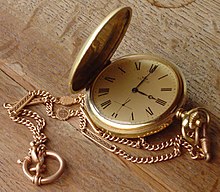
Back ساعة جيب Arabic Èrluji kantong BEW Джобен часовник Bulgarian পকেট ঘড়ি Bengali/Bangla Rellotge de butxaca Catalan Lommeur Danish Taschenuhr German Poŝhorloĝo Esperanto Reloj de bolsillo Spanish Taskukell Estonian



A pocket watch is a watch that is made to be carried in a pocket, as opposed to a wristwatch, which is strapped to the wrist.
They were the most common type of watch from their development in the 16th century until wristwatches became popular after World War I during which a transitional design, trench watches, were used by the military. Pocket watches generally have an attached chain to allow them to be secured to a waistcoat, lapel, or belt loop, and to prevent them from being dropped. Watches were also mounted on a short leather strap or fob, when a long chain would have been cumbersome or likely to catch on things. This fob could also provide a protective flap over their face and crystal. Women's watches were normally of this form, with a watch fob that was more decorative than protective. Chains were frequently decorated with a silver or enamel pendant, often carrying the arms of some club or society, which by association also became known as a fob. Ostensibly practical gadgets such as a watch winding key, vesta case, seal, and/or a cigar cutter also appeared on watch chains, although usually in an overly decorated style. Also common are fasteners designed to be put through a buttonhole and worn in a jacket or waistcoat, this sort being frequently associated with and named after train conductors.
An early reference to the pocket watch is in a letter in November 1462 from the Italian clockmaker Bartholomew Manfredi to the Marchese di Mantova Federico Gonzaga,[citation needed] where he offers him a "pocket clock" better than that belonging to the Duke of Modena. By the end of the 15th century, spring-driven clocks appeared in Italy, and in Germany. Peter Henlein, a master locksmith of Nuremberg, was regularly manufacturing pocket watches by 1526. Thereafter, pocket watch manufacture spread throughout the rest of Europe as the 16th century progressed. Early watches only had an hour hand, the minute hand appearing in the late 17th century.[1][2]
- ^ "Watch, Mechanical", Science and Technology, How It Works, vol. 19 (3rd ed.), Marshall Cavendish, 2003, p. 2651, ISBN 0-7614-7333-5 in How it Works, 2003, ISBN 0-7614-7314-9.
- ^ Campbell, Gordon (2006), The Grove encyclopedia of decorative arts, vol. 1, Oxford University Press, p. 253, ISBN 0-19-518948-5.